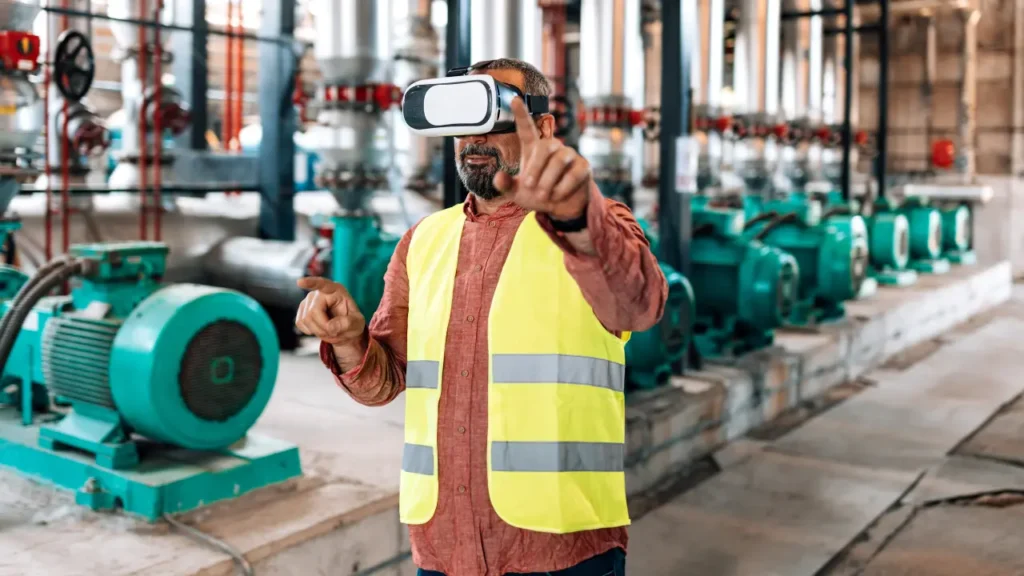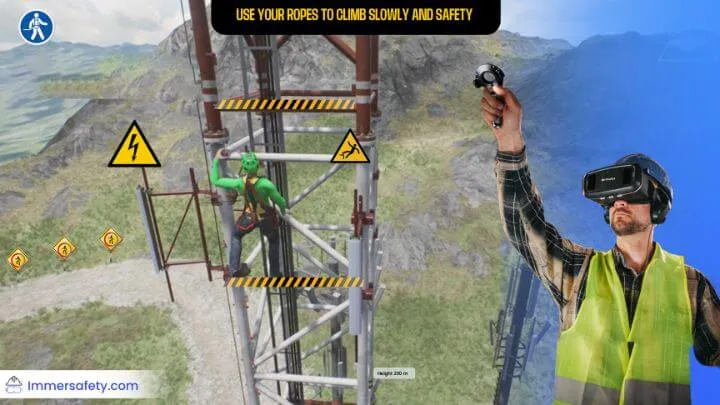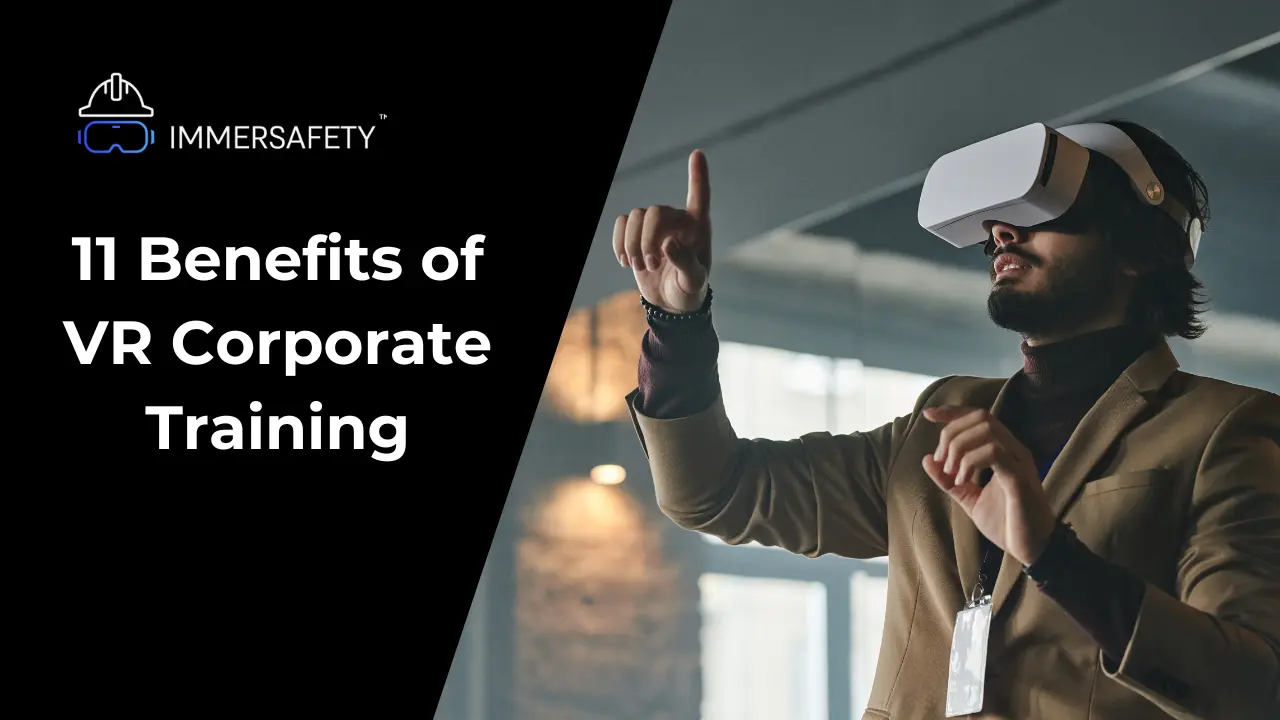In today’s rapidly evolving corporate landscape, staying ahead of the curve requires embracing innovative approaches to employee training and development. Virtual Reality (VR) technology has emerged as a game-changer, revolutionizing corporate training by offering immersive and interactive learning experiences.
Let’s delve into 11 compelling benefits of VR corporate training and how it’s transforming learning in the digital age.
11 Benefits of VR Corporate Training
1. Immersive Learning Environments:

Imagine a manufacturing company implementing VR training for equipment maintenance.
Employees can enter a virtual factory floor where they interact with machinery, identify components, and practice troubleshooting procedures in a lifelike environment. This immersive experience allows them to gain practical skills and confidence before working on actual equipment.
2. Hands-On Practice:
In the healthcare sector, VR training can simulate medical procedures such as surgery or patient care. Surgeons can practice surgical techniques, perform virtual operations, and respond to simulated complications—all without risking patient safety. This hands-on practice enhances proficiency and reduces the learning curve in real clinical settings.
3. Enhanced Engagement:
A retail organization may use VR simulations to train sales associates in customer service skills. Employees immerse themselves in virtual store scenarios, interact with virtual customers, and handle various sales situations. The interactive nature of the training keeps employees engaged, improving their communication and sales techniques.
4. Personalized Learning:
Consider an IT company providing cybersecurity training through VR modules. Each employee undergoes a personalized training program based on their role, experience level, and skill gaps. Advanced learners may encounter more complex cyber threats in their simulations, while beginners receive foundational concepts and guidance.
5. CostEffective Training:
A logistics company invests in VR training for forklift operators. Instead of scheduling costly onsite training sessions, employees access VR modules on forklift operations from their workstations. This eliminates the need for specialized equipment and reduces training-related expenses, resulting in significant cost savings over time.
6. Time Efficiency:
An insurance firm introduces VR training for claims adjusters. Employees can complete training modules at their convenience, whether during downtime or outside regular office hours. This flexibility minimizes disruptions to workflow and allows employees to balance training with their daily responsibilities, maximizing time efficiency.
7. Safe Learning Environment:

In the construction industry, VR training prepares workers for working at heights or operating heavy machinery. Employees practice safety procedures in virtual environments, such as harnessing techniques or crane operation, without exposing themselves to real-world risks. This ensures that they are well prepared for hazardous situations on actual job sites
See our -> Reasons to Invest In VR Construction Training
8. Scalability and Accessibility:
A global consulting firm adopts VR training for leadership development programs. Executives from different regions can participate in virtual workshops, teambuilding exercises, and leadership simulations from their respective offices. This scalable approach ensures consistent training delivery across diverse locations and time zones.
9. RealTime Feedback and Assessment:
A hospitality chain uses VR training for customer service skills development. As employees interact with virtual guests, their performance is monitored in real-time, assessing factors like communication effectiveness and problem-solving abilities. Immediate feedback helps employees refine their skills and address areas for improvement on the spot.
10. Remote Collaboration:
An automotive manufacturer conducts virtual team meetings and project collaborations using VR technology. Design engineers from different locations can review 3D models, discuss design modifications, and simulate assembly processes together in virtual environments. This remote collaboration fosters innovation and accelerates project timelines.
11. Competitive Advantage:
A technology startup differentiates itself in the market by offering VR-based onboarding and product training for clients. The company’s innovative approach to training demonstrates its commitment to cutting-edge solutions and customer satisfaction. As a result, the startup attracts top talent, wins new clients, and establishes itself as a leader in its industry.
FAQ’s
What is VR corporate training, and how does it work?
VR corporate training utilizes virtual reality technology to create simulated environments where employees can undergo training exercises and simulations. Users wear VR headsets to immerse themselves in these virtual environments, allowing for interactive and realistic learning experiences.
What are the benefits of VR corporate training over traditional training methods?
VR corporate training offers numerous advantages, including enhanced engagement, hands-on practice in a safe environment, personalized learning experiences, cost-effectiveness, and scalability. These benefits result in more effective training outcomes and higher levels of employee retention.
Is VR corporate training suitable for all industries and job roles?
While VR corporate training is versatile and can be applied across various industries, its suitability depends on factors such as the nature of the training content, the availability of VR technology, and the specific learning objectives. Industries such as healthcare, manufacturing, retail, and hospitality have seen successful implementations of VR training.
How can companies implement VR corporate training programs?
Implementing VR corporate training involves several steps, including assessing training needs, developing or procuring VR content, acquiring VR hardware and software, integrating VR training into existing learning management systems (LMS), and providing support and guidance to employees during the training process.
What are some examples of successful VR corporate training initiatives?
Companies across various industries have embraced VR corporate training with impressive results. For instance, automotive manufacturers use VR simulations to train assembly line workers, healthcare organizations utilize VR for medical simulations and surgical training, and retail chains implement VR for customer service and sales training. These examples demonstrate the versatility and effectiveness of VR in corporate training settings.
Final Thoughts:
In conclusion, VR corporate training offers a multitude of benefits that are reshaping the way organizations approach employee learning and development.
From immersive learning experiences to personalized instruction and cost-effective training delivery, VR technology is revolutionizing corporate training and paving the way for a more skilled, engaged, and competitive workforce in the digital age.


